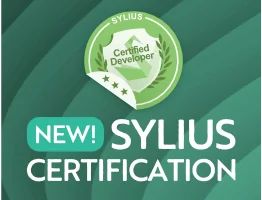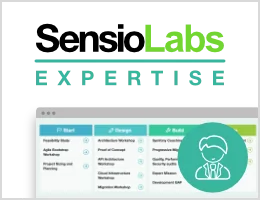The BrowserKit Component
The BrowserKit component simulates the behavior of a web browser, allowing you to make requests, click on links and submit forms programmatically.
Installation
1
$ composer require symfony/browser-kitNote
If you install this component outside of a Symfony application, you must
require the vendor/autoload.php file in your code to enable the class
autoloading mechanism provided by Composer. Read
this article for more details.
Basic Usage
See also
This article explains how to use the BrowserKit features as an independent component in any PHP application. Read the Symfony Functional Tests article to learn about how to use it in Symfony applications.
Creating a Client
The component only provides an abstract client and does not provide any backend
ready to use for the HTTP layer. To create your own client, you must extend the
AbstractBrowser class and implement the
doRequest() method.
This method accepts a request and should return a response:
1 2 3 4 5 6 7 8 9 10 11 12 13 14
namespace Acme;
use Symfony\Component\BrowserKit\AbstractBrowser;
use Symfony\Component\BrowserKit\Response;
class Client extends AbstractBrowser
{
protected function doRequest($request): Response
{
// ... convert request into a response
return new Response($content, $status, $headers);
}
}For a simple implementation of a browser based on the HTTP layer, have a look
at the HttpBrowser provided by
this component. For an implementation based
on HttpKernelInterface, have a look at the HttpClientKernel
provided by the HttpKernel component.
Making Requests
Use the request() method to make HTTP requests. The first two arguments are the HTTP method and the requested URL:
1 2 3 4
use Acme\Client;
$client = new Client();
$crawler = $client->request('GET', '/');The value returned by the request() method is an instance of the
Crawler class, provided by the
DomCrawler component, which allows accessing
and traversing HTML elements programmatically.
The jsonRequest() method,
which defines the same arguments as the request() method, is a shortcut to
convert the request parameters into a JSON string and set the needed HTTP headers:
1 2 3 4 5
use Acme\Client;
$client = new Client();
// this encodes parameters as JSON and sets the required CONTENT_TYPE and HTTP_ACCEPT headers
$crawler = $client->jsonRequest('GET', '/', ['some_parameter' => 'some_value']);The xmlHttpRequest() method,
which defines the same arguments as the request() method, is a shortcut to
make AJAX requests:
1 2 3 4 5
use Acme\Client;
$client = new Client();
// the required HTTP_X_REQUESTED_WITH header is added automatically
$crawler = $client->xmlHttpRequest('GET', '/');Clicking Links
The AbstractBrowser is capable of simulating link clicks. Pass the text
content of the link and the client will perform the needed HTTP GET request to
simulate the link click:
1 2 3 4 5 6
use Acme\Client;
$client = new Client();
$client->request('GET', '/product/123');
$crawler = $client->clickLink('Go elsewhere...');If you need the Link object that
provides access to the link properties (e.g. $link->getMethod(),
$link->getUri()), use this other method:
1 2 3 4
// ...
$crawler = $client->request('GET', '/product/123');
$link = $crawler->selectLink('Go elsewhere...')->link();
$client->click($link);The click() and
clickLink() methods
can take an optional serverParameters argument. This
parameter allows to send additional information like headers when clicking
on a link:
1 2 3 4 5 6 7 8 9 10 11
use Acme\Client;
$client = new Client();
$client->request('GET', '/product/123');
// works both with `click()`...
$link = $crawler->selectLink('Go elsewhere...')->link();
$client->click($link, ['X-Custom-Header' => 'Some data']);
// ... and `clickLink()`
$crawler = $client->clickLink('Go elsewhere...', ['X-Custom-Header' => 'Some data']);Submitting Forms
The AbstractBrowser is also capable of submitting forms. First, select the
form using any of its buttons and then override any of its properties (method,
field values, etc.) before submitting it:
1 2 3 4 5 6 7 8 9 10 11 12 13 14 15 16 17 18 19 20 21 22 23 24 25 26
use Acme\Client;
$client = new Client();
$crawler = $client->request('GET', 'https://github.com/login');
// find the form with the 'Log in' button and submit it
// 'Log in' can be the text content, id, value or name of a <button> or <input type="submit">
$client->submitForm('Log in');
// the second optional argument lets you override the default form field values
$client->submitForm('Log in', [
'login' => 'my_user',
'password' => 'my_pass',
// to upload a file, the value must be the absolute file path
'file' => __FILE__,
]);
// you can override other form options too
$client->submitForm(
'Log in',
['login' => 'my_user', 'password' => 'my_pass'],
// override the default form HTTP method
'PUT',
// override some $_SERVER parameters (e.g. HTTP headers)
['HTTP_ACCEPT_LANGUAGE' => 'es']
);If you need the Form object that
provides access to the form properties (e.g. $form->getUri(),
$form->getValues(), $form->getFields()), use this other method:
1 2 3 4 5 6 7 8 9
// ...
// select the form and fill in some values
$form = $crawler->selectButton('Log in')->form();
$form['login'] = 'symfonyfan';
$form['password'] = 'anypass';
// submit that form
$crawler = $client->submit($form);Custom Header Handling
The optional HTTP headers passed to the request() method follow the FastCGI
request format (uppercase, underscores instead of dashes and prefixed with HTTP_).
Before saving those headers to the request, they are lower-cased, with HTTP_
stripped, and underscores converted into dashes.
If you're making a request to an application that has special rules about header
capitalization or punctuation, override the getHeaders() method, which must
return an associative array of headers:
1 2 3 4 5 6 7 8 9
protected function getHeaders(Request $request): array
{
$headers = parent::getHeaders($request);
if (isset($request->getServer()['api_key'])) {
$headers['api_key'] = $request->getServer()['api_key'];
}
return $headers;
}Cookies
Retrieving Cookies
The AbstractBrowser implementation exposes cookies (if any) through a
CookieJar, which allows you to store and
retrieve any cookie while making requests with the client:
1 2 3 4 5 6 7 8 9 10 11 12 13 14 15 16 17 18 19 20 21 22 23
use Acme\Client;
// Make a request
$client = new Client();
$crawler = $client->request('GET', '/');
// Get the cookie Jar
$cookieJar = $client->getCookieJar();
// Get a cookie by name
$cookie = $cookieJar->get('name_of_the_cookie');
// Get cookie data
$name = $cookie->getName();
$value = $cookie->getValue();
$rawValue = $cookie->getRawValue();
$isSecure = $cookie->isSecure();
$isHttpOnly = $cookie->isHttpOnly();
$isExpired = $cookie->isExpired();
$expires = $cookie->getExpiresTime();
$path = $cookie->getPath();
$domain = $cookie->getDomain();
$sameSite = $cookie->getSameSite();Note
These methods only return cookies that have not expired.
Looping Through Cookies
1 2 3 4 5 6 7 8 9 10 11 12 13 14 15 16 17 18 19 20 21 22 23 24 25 26
use Acme\Client;
// Make a request
$client = new Client();
$crawler = $client->request('GET', '/');
// Get the cookie Jar
$cookieJar = $client->getCookieJar();
// Get array with all cookies
$cookies = $cookieJar->all();
foreach ($cookies as $cookie) {
// ...
}
// Get all values
$values = $cookieJar->allValues('http://symfony.com');
foreach ($values as $value) {
// ...
}
// Get all raw values
$rawValues = $cookieJar->allRawValues('http://symfony.com');
foreach ($rawValues as $rawValue) {
// ...
}Setting Cookies
You can also create cookies and add them to a cookie jar that can be injected into the client constructor:
1 2 3 4 5 6 7 8 9 10
use Acme\Client;
// create cookies and add to cookie jar
$cookie = new Cookie('flavor', 'chocolate', strtotime('+1 day'));
$cookieJar = new CookieJar();
$cookieJar->set($cookie);
// create a client and set the cookies
$client = new Client([], null, $cookieJar);
// ...Sending Cookies
Requests can include cookies. To do so, use the serverParameters argument of
the request() method
to set the Cookie header value:
1 2 3 4 5 6
$client->request('GET', '/', [], [], [
'HTTP_COOKIE' => new Cookie('flavor', 'chocolate', strtotime('+1 day')),
// you can also pass the cookie contents as a string
'HTTP_COOKIE' => 'flavor=chocolate; expires=Sat, 11 Feb 2023 12:18:13 GMT; Max-Age=86400; path=/'
]);Note
All HTTP headers set with the serverParameters argument must be
prefixed by HTTP_.
History
The client stores all your requests allowing you to go back and forward in your history:
1 2 3 4 5 6 7 8 9 10 11 12 13 14
use Acme\Client;
$client = new Client();
$client->request('GET', '/');
// select and click on a link
$link = $crawler->selectLink('Documentation')->link();
$client->click($link);
// go back to home page
$crawler = $client->back();
// go forward to documentation page
$crawler = $client->forward();You can delete the client's history with the restart() method. This will
also delete all the cookies:
1 2 3 4 5 6 7
use Acme\Client;
$client = new Client();
$client->request('GET', '/');
// reset the client (history and cookies are cleared too)
$client->restart();Making External HTTP Requests
So far, all the examples in this article have assumed that you are making internal requests to your own application. However, you can run the exact same examples when making HTTP requests to external web sites and applications.
First, install and configure the HttpClient component. Then, use the HttpBrowser to create the client that will make the external HTTP requests:
1 2 3 4
use Symfony\Component\BrowserKit\HttpBrowser;
use Symfony\Component\HttpClient\HttpClient;
$browser = new HttpBrowser(HttpClient::create());You can now use any of the methods shown in this article to extract information, click links, submit forms, etc. This means that you no longer need to use a dedicated web crawler or scraper such as Goutte:
1 2 3 4 5 6 7 8
$browser = new HttpBrowser(HttpClient::create());
$browser->request('GET', 'https://github.com');
$browser->clickLink('Sign in');
$browser->submitForm('Sign in', ['login' => '...', 'password' => '...']);
$openPullRequests = trim($browser->clickLink('Pull requests')->filter(
'.table-list-header-toggle a:nth-child(1)'
)->text());Tip
You can also use HTTP client options like ciphers, auth_basic and
query. They have to be passed as the default options argument to the
client which is used by the HTTP browser.
Dealing with HTTP responses
When using the BrowserKit component, you may need to deal with responses of
the requests you made. To do so, call the getResponse() method of the
HttpBrowser object. This method returns the last response the browser received:
1 2 3 4
$browser = new HttpBrowser(HttpClient::create());
$browser->request('GET', 'https://foo.com');
$response = $browser->getResponse();If you're making requests that result in a JSON response, you may use the
toArray() method to turn the JSON document into a PHP array without having
to call json_decode() explicitly:
1 2 3 4 5
$browser = new HttpBrowser(HttpClient::create());
$browser->request('GET', 'https://api.foo.com');
$response = $browser->getResponse()->toArray();
// $response is a PHP array of the decoded JSON contents
